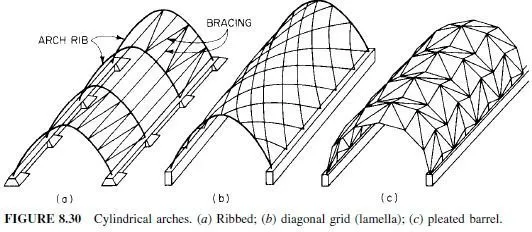Cables, more commonly referred to as wire rope, are sometimes used in buildings to support long-span roofs, to suspend floorbeams from upper levels, and as bracing members to resist wind loads. Wire rope is made of three basic components: wires, strands, and a core. Each rope end usually is equipped with a fitting, an accessory for attaching the cable to an anchorage or part of a structure.
A wire is a single, continuous length of metal cold-drawn from a rod. A strand consists of multiple wires placed helically around a central wire to produce a symmetrical section.
A rope is comprised of strands laid helically around a core composed of a strand or another wire. Strand, in general, is stronger and has a higher modulus of elasticity than rope of the same size but is less flexible.
Design Strength. The breaking strength is the ultimate load registered for a wire rope during a tension test. For design, the breaking strength is divided by a design factor, which is the ratio of the breaking strength to the expected design load. This factor plays an important role in determining the life expectancy of a rope. (Excessive loading will impair a ropes serviceability.) The American Iron and Steel Institute Wire Rope Users Manual suggests a common design factor of 5.
Breaking strength is a function of rope classification, coating, and diameter. The AISI Wire Rope Users Manual lists industry-accepted strengths. ASTM A603, Standard Specification for Zinc-Coated Steel Wire Rope, also gives minimum breaking strengths.
Design Considerations. Cables should be assumed to have no resistance to bending. Design should take in to account stretch from both tensioning of the rope and the applied loads.
Also, design should consider deflections and resulting stresses caused by changes in magnitude and position of loads. In addition, effects of temperature variations should be accounted for in the design of both the cables and the supporting structure. Design provisions are also necessary for expansion and contraction of wire rope.
Wire rope supporting floors or roofs should be proportioned with due consideration for limiting deflections produced by the design loads.
(See also Secs. 1 and 4.)


